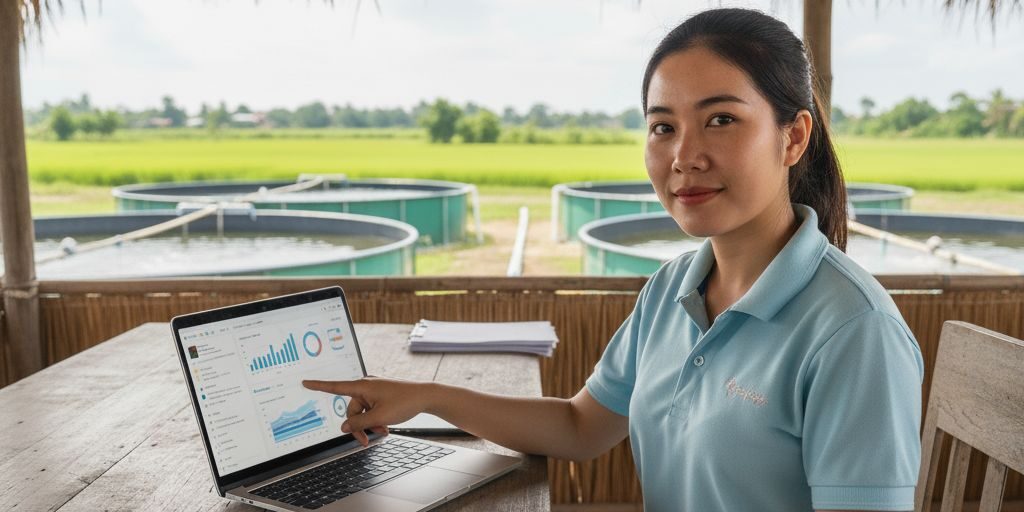- Software Gestor para Aquicultura
- (85) 2139-6730
- contato@despesca.com.br
Cost Per Pound of Fish: The Question Your Paper Notes Can’t Answer

Alternative Proteins: The Sustainable Future of Aquaculture Feed
30/09/2025
10 Essential Precautions During Fish Harvesting to Ensure Seafood Quality
02/10/2025Let’s get straight to the point: do you know your cost per pound of fish? If the answer isn’t immediate and precise, it’s likely your management methods are limiting your profitability. In today’s increasingly competitive market, operating without knowing this number is like sailing without a compass. The root of this uncertainty, for many farms, lies in a traditional and risky method: notes in notebooks and printed spreadsheets.
This manual system is not only inefficient but also masks the true costs of your operation, turning valuable data into a pile of papers difficult to analyze. This article discusses why migrating to a management software like Despesca is the definitive step to answer this crucial question and, from there, optimize your entire production cycle to maximize profits.
The Hidden Costs Behind Paper and Spreadsheets
Relying on manual notes makes it almost impossible to accurately calculate production costs. Each sheet of paper represents a point of failure that can distort your final calculations. For example, an error in noting the amount of feed provided or the loss of an aeration energy consumption record directly impacts the final cost of your product.
Furthermore, a lack of integration is a chronic problem. Information on input stock is in one place, biometric data in another, and labor costs in a third spreadsheet. Trying to unify all this manually at the end of the cycle is a slow process, susceptible to calculation errors, and doesn’t offer a real-time view. Therefore, management becomes reactive. Instead of adjusting the strategy during the cycle to correct cost deviations, producers often only realize the loss when it’s too late.
Digital Management: Bringing the True Cost to the Surface
Transitioning to a digital platform is the most effective way to confidently answer the question: “What is your cost per pound of fish?”. A specialized management software centralizes every cost variable in a single, integrated system. From the purchase of post-larvae and fingerlings, through feed and probiotic consumption, to electricity and labor expenses—everything is recorded and accounted for.
Thus, information ceases to be static and transforms into business intelligence. The system cross-references cost data with production data—such as daily weight gain and estimated survival—to calculate and update the cost per pound in real-time. This allows the manager to monitor the evolution of this fundamental indicator throughout the entire cycle, enabling quick interventions to keep the operation within profitability targets.
With Despesca, the Answer is on Your Dashboard
Specialized software like Despesca is designed to give producers total control over their costs, turning financial management into a competitive advantage.
Calculating Production Cost in Real-Time
The system’s primary function is to answer the central question. By entering all expenses and recording batch development through precise biometrics, the platform automatically calculates the accumulated cost and compares it with the total biomass in the pond. The result is a clear number: your production cost per pound, updated with every new record.
Data-Driven Optimization
Knowing the cost is the first step. The second is to optimize it. With detailed reports, it’s possible to identify exactly where the biggest financial bottlenecks are. Feed, being the largest cost, can be managed with extreme precision, adjusting feeding to achieve the best Feed Conversion Ratio (FCR) and, consequently, reduce the cost per pound. We elaborate on the importance of this metric in our article on the importance of cost management in production.
In conclusion, continuing to use paper notes means choosing to remain without the answer to the most important question for your business. Knowing your cost per pound of fish is the foundation for any pricing, negotiation, and growth strategy. Tools like Despesca are not just a technological advancement; they are essential for ensuring the financial health and long-term competitiveness of your farm.




